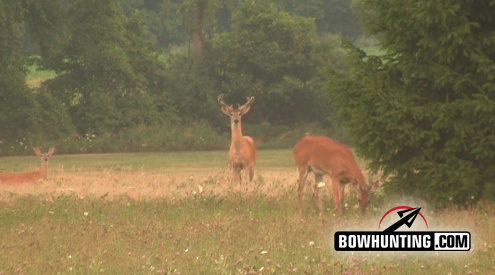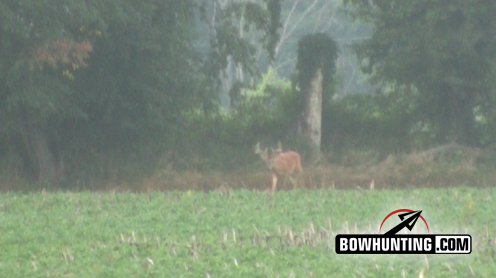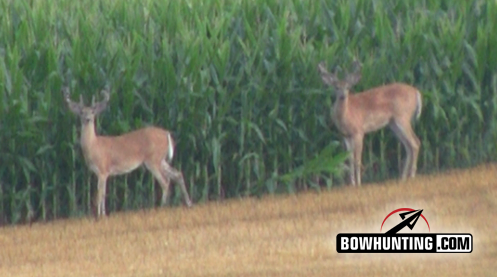LAST UPDATED: May 8th, 2015
I recently watched a morning news show that featured a fella literally frying an egg and cooking a pizza on a sidewalk. I kid you not. It has just been one of those summers. One of those shut the windows, lock yourself inside with the AC blasting kind of summers. But if you are one of the few brave souls that can stand the heat, there is much to be done in preparation for those big whitetails this time of year. For me, one of my favorite activities come July and August is scouting and filming velvet bucks. It’s a great way to scout, get motivated for the season and just plain have fun. So if you’re deer hunting itch needs a good scratching, jump in a car or hike to a field and get ready to glass some bucks. Here are six tips to help you make the most of your time scouting fields for whitetails this year!
Know Your Goal: When taking on the task of summer field scouting, I typically have three goals in mind. Number one, is to get a better idea of what bucks are in the general area. It’s important to realize that the majority of bucks range in one area during the summer and then typically move somewhere new around the September time frame. That being said, most bucks you see in the fields now, won’t be there come hunting season. But you can still get a good idea of the potential your area holds, and a few of those fellas you’re seeing now might still stick around.
Number two, given that a few of those bucks stay around, I want to start patterning them if possible. If you have a September opener, this is a great option. Come late August, early September you’ve got a great chance of locking in on a deers entry point into a field. Take note of where he’s coming out and what conditions where upon you that night. This can be hugely helpful as you plan out the first days of your season.
Lastly and possibly most importantly, I love scouting summer bucks just to have fun! Few things get me as pumped as seeing a giant velvet buck 100 yards away munching on soybeans. It’s the kind of image that will keep you up at night.
Pick Your Spots: When I’m scouting fields in the summer, I pay attention to several areas. First and foremost, I’m watching any food sources on properties I can hunt. This is an obvious choice. But on top of that, I’m also scouting out fields in the surrounding area, about a mile or two around my properties. There’s a chance these bucks could move the mile or more over to your property later in the year, so it’s just as helpful to see what the neighbors have on their properties now. The more times you see a buck, the better idea you’ll have of his status on your shoot/don’t shoot list. So seeing this buck a mile away from your property now a couple times, could save you a few seconds of decision making come October.
Focus On Food: When it comes to scouting summer bucks, the name of the game is food sources! When I was a kid, I used to think every field I passed on the highway would be “an awesome place to hunt!” But it turns out, every open area isn’t a deer magnet! Especially during the summer. This time of year, food is plentiful so deer can be picky. During the late summer months, crops like soybeans, clover and alfalfa (in the Midwest at least) will be top choices for most deer herds. Find these food sources, watch them consistently and you’ll get a great idea of the quality bucks in your area.
Pay Attention to the Wind: Once you know of a few good food sources that bucks are coming out on, it can get tough to determine which one you’ll have the best chance to see bucks on on a given night. The best determinant I’ve found is wind direction. Especially with mature bucks, I’ve found that wind direction can determine what food source they’ll use. If you see a good buck in your soybean field with a west wind, count on him most likely coming back there on west wind days, but heading elsewhere (if there are other good options) on different direction days. There’s always exceptions to the rule, but I definitely feel better about my chances of sitting on a field with X wind, if I’ve seen a good buck out there with X wind before.
Remember the Weather: If you’re short on time, you’ve got to budget your sits on fields or drive-bys in your truck to the most likely of days and times. I’ve found several types of weather effect deer activity in food sources. This time of year, heat is a major factor. On those days where temps are high 80’s or more, I wouldn’t expect mature bucks to hit those fields til just before dark. (At least in the North, where my experiences have taken place). So on those days, don’t bother driving around a couple hours before dark. The best days for watching fields tend to be rainy or just post-rain, cloudy and cool. One nights like this, you could see good bucks in the food an hour or more before dark!
Arm Yourself Well: When scouting deer in fields, you’re only as good as your gear. If you’re trying to get a good look at bucks far off in a field, a good spotting scope or binoculars are crucial. A tripod, window mount or similar tool will also be really helpful in keeping your glass steady when looking several hundred yards away at a buck.
So while the dog days of summer can be a real drag, don’t miss out on this exciting part of the deer year. I’ve found the summer months to be some of my favorite, as I build my hit list of bucks, drool over giant velvet bucks in fields and map out my strategies for the coming season. Keep the above six tips in mind and your summer nights will be filled with good times, tall tined bucks and some good deer stories to boot!








